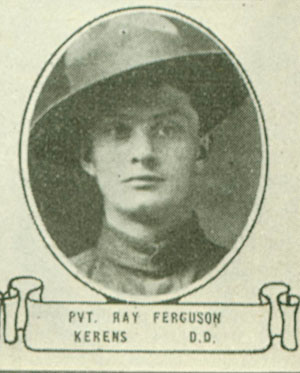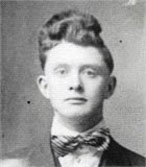

Remember...
Coleman Ray Ferguson
1896-1918
"No commander was ever privileged to lead a finer force; no commander ever derived greater inspiration from the performance of his troops."
John J. Pershing
Army Private Ray Ferguson (Shown as "Coleman R." in the 1900 and 1910 Federal Census, but known as "Ray," which is how he signed his draft registration) was born on February 4, 1896, in Kerens, Randolph County, West Virginia, one of fourteen children born to Hoy M. Ferguson and Margaret Kalar Ferguson. Ray's siblings were Lairy DeWitt, Lena May (Mrs. Irvin Forrest Clinebell), Ella May (Mrs. Richard H. Clinebell), Belvie Bird (died young), Harry Dasher, Mollie E. (Mrs. Oran G. Wilson), Alberta P. (Mrs. Frank W. Murphy), Troy Cicero, Solomon (died young), Nancy Olive (Mrs. Dariel Phillips), Chloe M. (Mrs. Rufus S. Ferguson), Willie R., and Lucy R. (Mrs. Russell Phares).
Ray's grandfather, Pvt. Robert Ferguson, was a soldier in the Virginia Militia during the War of 1812. Robert was a blacksmith and, when a youth, and had shod a horse for George Washington.
| On February 7, 1917, Ray Ferguson was united in marriage with Marie Plymale in Akron, Ohio. Marie was born on April 2, 1896, in Burnsville, Braxton County, West Virginia. Her parents were William Calvin Plymale and Elzarie Riffle Plymale. Ray and Marie lived in Akron and were employed as workers in one of the rubber plants for which Akron is known. They had a daughter named Ray Marie. |  Coleman Ray Ferguson. Courtesy Larry Ferguson |
Ray registered for the World War I draft on June 5, 1917, in Randolph County. The registration form describes him as being of medium height and medium build, with blue eyes and red hair. He claimed an exemption from the draft because he needed to provide support to his wife.
Although Ray Ferguson had claimed an exemption from the draft because he was married, he was called to serve in the American Expeditionary Forces in the U. S. Army, the Medical Detachment of the 53rd Infantry Regiment.
The 53rd Infantry Regiment, along with the 51st, 52nd, and 54th were part of the 6th Infantry Division. The 6th Infantry Division also included the 16th, 17th and 18th Machine-Gun Battalions and the 3rd, 11th and 78th Field Artillery Regiments. They departed from New York on July 4, 1918. On August 31, after a month of training in Western France, the 6th Division was assigned to the Vosges Sector. There they defended against liquid fire and grenades launched by German raiding parties.
On October 10, 1918, the 6th Division was reassigned to participate in the closing campaign of the war, the Meuse-Argonne Offensive, to pursue the rapidly retreating German forces. Marching through muddy rain-soaked fields, they moved to the front to keep up the brunt of the attack against the Germans. The Germans had outfitted artillery shells and grenades with mustard gas, which they fired at the American troops. During its three months of fighting at the front, the 6th Division lost 227 men who were killed in action or died of wounds.
It was during this campaign that Pvt. Ray Ferguson lost his life on October 26, 1918, a victim of pneumonia, probably resulting from exposure to mustard gas. His World War I service record indicates he died in a base hospital in Chaumont, France. Having been initially interred in that country, his body was returned in 1922 to Randolph County, West Virginia, where he was reburied in the Primitive Baptist Church in Montrose. An account of the services for Ray reads in part:
Final interment of the body of Ray Ferguson, Private, Medical Detachment, 53rd U.S. Infantry, American Expeditionary Forces, was made at the Old School Baptist Church Cemetery, Sunday morning, January 1st, 1922.. He can be counted among a host of soldiers who were unfortunate enough to have "gone west" during the few closing days of the World War and before that cheery news of Peace could reach them. But they have gained the real rest while their surviving comrades still have their troubles, worries and problems of life.The parents of the deceased soldier drove, in an open carriage, for an hour and a half in a driving snow storm and chilling wind to reach the church for the service.. Following a simple, but impressive service at the church, the body was born to the grave on a little hill close by, where it was consigned to the earth by the Minister and final military honors paid by H. W. Daniels Post No. 29 of the American Legion..
The services at the open grave were performed in a driving snow storm which swept over the bleak hills and recalled, to many of the ex-soldiers, the winter months of hardship and suffering which they had experienced with the American Expeditionary Forces. Such hardships broke the physique of many a hardy country boy like Ray Ferguson. (Source: "Military Funeral of Ray Ferguson," Randolph Review, 5 Jan.1922.)
The men of the 6th Infantry Division distinguished themselves in combat, and many of them earned the Distinguished Service Cross and Croix de Guerre. General Pershing highly commended the 6th Division for its contribution to the final victory.
Article prepared by Leon Armentrout
December 2014

West Virginia Archives and History welcomes any additional information that can be provided about these veterans, including photographs, family names, letters and other relevant personal history.